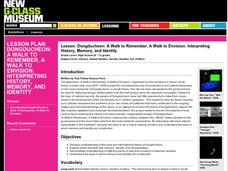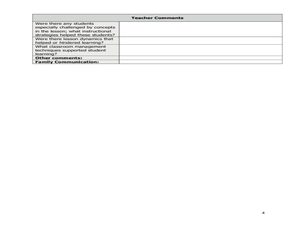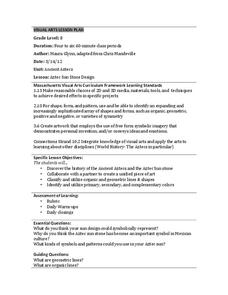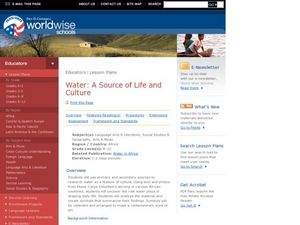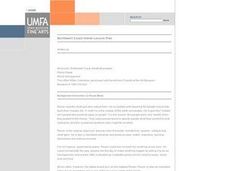Curated OER
Greek Pottery Designs
Get creative while exploring the art and history of the ancient Greeks. Learners create construction paper representations of Greek pottery, focusing on the differences between geometric and organic shapes. This project could enhance an...
Curated OER
Lesson: Dongducheon: A Walk to Remember, A Walk to Envision: Interpreting History, Memory, and Identity
Cultural discourse can start through a variety of venues. Learners begin to think about how our minds, memories, and identities shape our attitudes toward culture and history. They analyze seven pieces from the Dongducheon art exhibit...
Walters Art Museum
The Symbolism of Allegorical Art
Introduce learners to allegorical art with four bronze sculptures by Francesco Bertos. After modeling how to recognize bias and allegory in Bertos' Africa, class groups examine the other three sculptures in the series before creating...
Curated OER
Symmetry in Relief
Students explore radial symmetry. In this 3 dimensional art and geometry lesson, students identify examples of radial symmetry in everyday objects. Students create an imprint using radial symmetry on clay tiles.
Curated OER
Christmas Tree Shaped Poems
Students think about ways in which they can spread joy during the holiday season. They create poems in the shape of a Christmas tree. Pupils use formatting tools in Microsoft Word to format the text of the poem. Students discuss ways...
PreKinders
Bingo Templates
Bingo! Find five in a row with a set of fun and creative bingo graphic organizers. The sheets feature shapes such as leaves, monkeys, dinosaurs, fire trucks, as well as symbols for Christmas, Easter, and Valentine's Day.
Curated OER
Understanding "The Stans"
Students explore and locate "The Stans" in Central Asia to create, write and illustrate maps, graphs and charts to organize geographic information. They analyze the historical and physical characteristics of Central Asia via graphic...
Curated OER
Ancient Aztecs
Is it a calendar? A religious symbol? A political statement? One thing for certain is that Aztec sun stone designs remain an important symbol in Mexican cultural art. Young artists craft their own Aztec Sun design incorporating ideas...
Curated OER
Conflict, Tragedy and the Power of Art
Students investigate some the ways art has responded to conflict throughout history. Through teacher lecture and demonstration, students witness the historical background of a piece of artwork and how it reflects the conflict it...
Curated OER
Water: A Source of Life and Culture
Students explore water as a feature of culture. For this visual arts lesson, students consider the necessity of water in every culture. Students select water symbols and use their artistic skills to create water symbol silhouettes.
Curated OER
Create a Fan Design
Students design fans with organic shapes and contrasting colors. They recognize t'aeguk design as a visual element of Korean culture.
Curated OER
Buying the Writes
Students explore the connections between non-fiction and fiction best-seller lists and current events that are shaping readers' lives and choices.
Curated OER
Trying Teens
Students explore the court cases and legal organizations that were instrumental in creating a system of juvenile justice in the United States, then present their findings in a composite timeline.
National Endowment for the Humanities
Background on the Patriot Attitude toward the Monarch
Learners explain the Patriot attitude toward the British monarchy, which helps them embrace the Founders' reluctance to have a strong executive under the Articles of Confederation as well as their desire to build in checks of executive...
Curated OER
Arkansas is Our State: Differentiating Between a State and a Country
An ambitious geography lesson is geared toward kindergartners. They discover what the differences are between states and countries. They look at maps of Arkansas, and learn what the shapes and lines mean. Additionally, they create a...
Curated OER
Introducing Maps Through Dance
Students are introduced to the key concepts of maps; direction, pathway/line, shape and symbol. They create the pathways and shapes they have "mapped" out on paper on the floor. They dance along the paths.
Curated OER
Math: The Cathedral Project
Second graders take a field trip to a nearby church or other historical building and examine it from a mathematical perspective. In groups, they calculate the seating capacity, describe the window patterns, differentiate types of...
Curated OER
America's Civil Rights Movement, Cubing
Students explore cubing as a graphic organizer to better explain the key concepts of the Civil Rights Movement and take positions on key concepts regarding the Movement.
Curated OER
Historical Figures
Second graders identify a historical figure, his or her societal contributions and basic biography using a Kidspiration graphic organizer and library resources. They use the Internet to conduct an historical treasure hunt in groups.
Curated OER
Northwest Coast Indian Lesson Plan
Students create traditional hats. In this visual arts lesson, students design and create traditional hats that highlight animal features, line design, and geometric shapes in the style of the Kwakiutl.
Curated OER
Northwest Coast Indian Raven Mask Lesson Plan
Learners create raven masks. In this Northwest Coast Native American lesson, students design and create Kwakiutl-style hats that feature the shapes, animals, and colors used by the Northwest Native Americans.
Curated OER
Kente Cloths
Second graders create examples of Kente cloths using paper, markers, and paints in this multi-cultural Art lesson for the second grade. The two part lesson includes an introduction of Kente Cloth designs and can be accomplished in one day.
Curated OER
A Walk Around the School: Mapping Places Near and Far
After reading Pat Hutchins’ Rosie’s Walk, have your young cartographers create a map of Rosie’s walk. Then lead them on a walk around the school. When you return class members sequence the walk by making a list of how the class got from...
Curated OER
Location, Location, Location: Civilization's Ultimate Advantage
Students discover how geographical advantages, locational and regional, ultimately led to western Eurasian societies' disproportionate accounting of world power and innovation. They utilize a workbook which can be downloaded within this...

